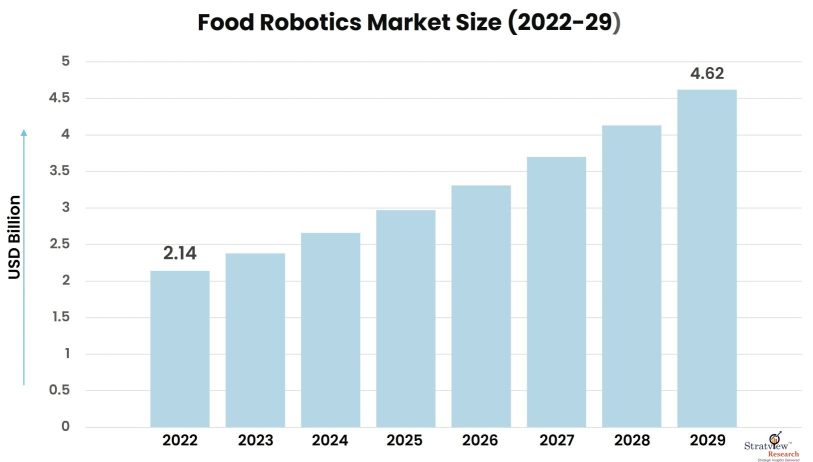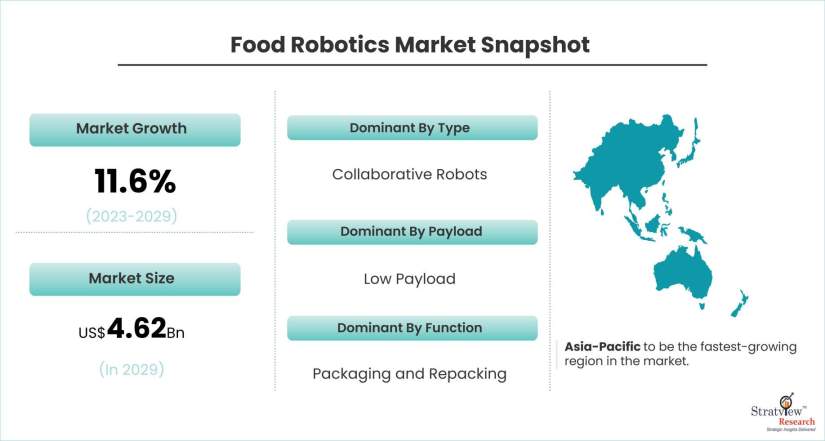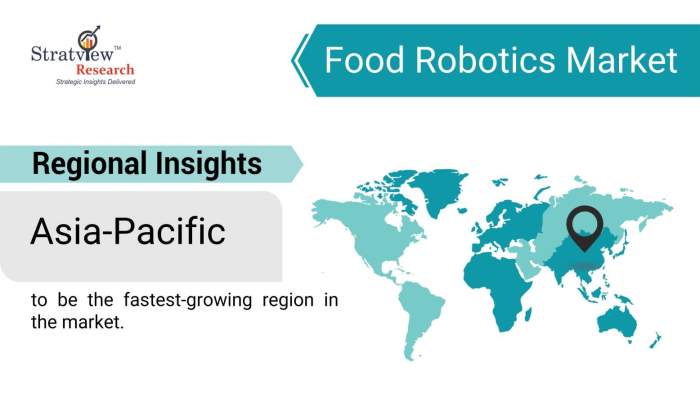Market Insights
The food robotics market was estimated at USD 2.14 billion in 2022 and is likely to grow at a CAGR of 11.6% during 2023-2029 to reach USD 4.62 billion in 2029.

Want to know more about the market scope? Register Here
Market Dynamics
Introduction
Food robotics deals with the machines that are used in the food & beverage industry to perform different complex tasks such as picking, packing, and palletizing. Food robotics is widely used in the production of processed, frozen, dried, and chilled packaged food products. The food & beverage sector embraces automated technology to reduce cost, save time, and deliver better quality products.
This technology increases the storage capacity and systematic use of vertical space. Food robotic systems help to reduce the workload of employees and also work in combination with them for higher efficiency. Applications of robots in the food industry can deliver consistent personalized products when it comes to decorating and marking them properly. Such decorating includes preparing, cooking, and garnishing pizzas, decorating cakes in detail carefully, marking pastries, or branding chocolate.
Market Drivers
The food robotics industry is experiencing a significant increase in demand due to the rising need for food with the growing population and the desire for increased productivity in food processing. Furthermore, the food robotics market is expected to benefit from increased investments in automation within the food industry, presenting opportunities for growth.
Increasing demand for packaged food
In recent years, there has been a growing necessity to package food items to extend their shelf life and meet the demand for easily prepared and consumable products. This demand for packaged food has driven the market for food robotics, especially in countries such as the U.S., Japan, France, and Italy, where mass production of packaged food is common.
Automation of processes in large-scale food manufacturing plants is becoming increasingly prevalent to ensure consistency and quality in Stock Keeping Units (SKUs). Food robotics is being used more frequently to produce processed, frozen, dried, and chilled packaged food products.
The food robotics market is also being driven by the growth of the packaged dairy products and baked goods industries as these products are manufactured on a large scale globally.
Restraints: Dearth of skilled workforce in emerging economies
The implementation and adoption of food robotics technology necessitates a skilled workforce with expertise in disciplines such as electrical, embedded software, and mechanical engineering, which are essential for installing and maintaining robots. However, there is a shortage of highly qualified professionals with specific skills required to develop advanced, high-value-added robots integrated with cutting-edge technology.
In countries like China, India, and Brazil, which have high potential for growth in the food and beverage industry, there is a significant lack of skilled personnel in this field. This is primarily due to the requirement of expertise in multiple engineering disciplines, which makes it difficult to find qualified faculty to teach these subjects.
Additionally, there are limited engineering branches that specialize in robotics, which further compounds the shortage of skilled labor. As a result, the development of skilled personnel in the food robotics industry is likely to be a long-term goal, which poses a direct constraint on the growth of the food robotics market.

Want to have a closer look at this market report? Click Here
Key Players
The major players operating in the global market are:
- Mitsubishi Electric Corporation
- ABB Group
- Rockwell Automation, Inc.
- Kawasaki Heavy Industries Ltd.
- KUKA AG
- FANUC Corporation
- Seiko Epson Corporation
- Yaskawa Electric Corporation
- Staubli International Corporation
- Mayekawa Mfg Co. Ltd
- Bastian Solutions, Inc.
- Pearson Packaging System
- Chowbotics
- Starship Industries
- Cantrell
- Universal Robots A/S
- Karakuri Ltd.
- TM Robotics
- Retail Robotics
- Jungle Robotics GmbH
Note: The above list does not necessarily include all the top players in the market.
Are you the leading player in this market? We would love to include your name. Write to us at sales@stratviewresearch.com
Segment Analysis
By Type
The food robotics market is classified into six types, namely articulated robots, delta and parallel robots, collaborative robots, cartesian robots, cylindrical robots, and portal robots. The collaborative robots segment is projected to exhibit the highest compound annual growth rate (CAGR) during the forecast period.
This rapid growth can be attributed to the increasing awareness of the advantages of these robots in working environments that are unfavorable for human workers, such as humid greenhouses, refrigerated rooms, and hot ovens. Collaborative robots can relieve employees of repetitive tasks that can cause injury in such conditions.
Companies worldwide are adopting collaborative robots due to their rapid technological advancements and cost-effectiveness. For instance, Cascina Italia employs collaborative robots that process millions of eggs per day efficiently. This particular collaborative robot is produced by Universal Robots A/S and minimizes human intervention in the cumbersome process of preparing bulky packages for large-scale distribution. Additionally, it utilizes fenceless operation, allowing the cobot to work side-by-side with human workers in production lines.
By Payload Type
The market is segmented based on payload into three categories: high, low, and medium payload. The low payload segment is projected to register the highest CAGR during the forecast period. This rapid growth can be attributed to the segment's specialization in tasks such as pick-and-place, food handling, packaging and palletizing, sealing, labeling, and spraying, among others.
Additionally, the low payload segment can reduce cycle time and increase productivity in food manufacturing processes.
By Function Type
The market is segmented based on application into palletizing and depalletizing, packaging and repacking, pick and place, cutting and slicing, grading and sorting, butchery, quality inspection, and other applications. The packaging and repacking segment is anticipated to register the highest compound annual growth rate (CAGR) during the forecast period. This rapid growth can be attributed to the high utilization of packaging in the food industry, which can significantly speed up cycle times and improve productivity.
Regional Insights
Asia-Pacific to be the fastest-growing region in the market, mainly due to increasing concerns regarding food hygiene and lifestyle changes that have led to a higher demand for ready-to-eat and packaged food products. Additionally, the rise in consumer income has further fueled the demand for advanced packaged food and beverages throughout the region.
Among the countries in the Asia-Pacific region, China has been at the forefront of food adoption and is a significant contributor to the growth of the food robotics market.

Know the high-growth countries in this report. Register Here
Research Methodology
- This strategic assessment report from Stratview Research provides a comprehensive analysis that reflects today’s food robotics market realities and future market possibilities for the forecast period.
- The report segments and analyzes the market in the most detailed manner in order to provide a panoramic view of the market.
- The vital data/information provided in the report can play a crucial role for market participants as well as investors in the identification of the low-hanging fruits available in the market as well as to formulate growth strategies to expedite their growth process.
- This report offers high-quality insights and is the outcome of a detailed research methodology comprising extensive secondary research, rigorous primary interviews with industry stakeholders, and validation and triangulation with Stratview Research’s internal database and statistical tools.
- More than 1,000 authenticated secondary sources, such as company annual reports, fact books, press releases, journals, investor presentations, white papers, patents, and articles, have been leveraged to gather the data.
- We conducted more than 15 detailed primary interviews with market players across the value chain in all four regions and industry experts to obtain both qualitative and quantitative insights.
Report Features
This report provides market intelligence in the most comprehensive way. The report structure has been kept such that it offers maximum business value. It provides critical insights into market dynamics and will enable strategic decision-making for existing market players as well as those willing to enter the market. The following are the key features of the report:
- Market structure: Overview, industry life cycle analysis, supply chain analysis.
- Market environment analysis: Growth drivers and constraints, Porter’s five forces analysis, SWOT analysis.
- Market trend and forecast analysis.
- Market segment trend and forecast.
- Competitive landscape and dynamics: Market share, Service portfolio, New Product Launches, etc.
- COVID-19 impact and its recovery curve
- Attractive market segments and associated growth opportunities.
- Emerging trends.
- Strategic growth opportunities for the existing and new players.
- Key success factors.
The food robotics market is segmented into the following categories:
By Type
- Articulated
- Cartesian
- Scara
- Parallel
- Cylindrical
- Collaborative
By Payload Type
By Function Type
- Palletizing
- Packaging and Repackaging
- Picking
- Processing
By Application Type
- Bakery & Confectionery Products
- Beverages
- Meat
- Poultry and Seafood
- Dairy Products
- Processed Food
- Fruits & Vegetables
By Region
- North America (Country Analysis: The USA, Canada, and Mexico)
- Europe (Country Analysis: Germany, France, The UK, Russia, and The Rest of Europe)
- Asia-Pacific (Country Analysis: Japan, China, India, and the Rest of Asia-Pacific)
- Rest of the World (Country Analysis: Brazil, Argentina, and Others)
Report Customization Options
With this detailed report, Stratview Research offers one of the following free customization options to our respectable clients:
Company Profiling
- Detailed profiling of additional market players (up to three players)
- SWOT analysis of key players (up to three players)
Competitive Benchmarking
- Benchmarking of key players on the following parameters: product portfolio, geographical reach, regional presence, and strategic alliances.
Custom Research: Stratview Research offers custom research services across the sectors. In case of any custom research requirement related to market assessment, competitive benchmarking, sourcing and procurement, target screening, and others, please send your inquiry to sales@Stratviewresearch.com.
Recent Developments
- In October 2022, Yaskawa opened the Robotics Technology Center as a new facility in Istanbul, Turkey.
- In October 2022, Grubhub, a prominent marketplace for food ordering and delivery, and Starship Technologies, a leading provider of autonomous delivery services, announced their partnership to offer robot delivery services on university campuses throughout the United States.
- In September 2022, Uber Technologies Inc. teamed up with start-up Nuro to trial food delivery using unmanned vehicles in several locations in the US, broadening its collaborations with companies specializing in creating autonomous machines.
- In January 2022, Mitsubishi Electric, an electronics equipment manufacturing company of the automaker, launched a trial program to investigate the benefits of autonomous robots. The company partnered with Cartken, a startup founded by Google alumni. They deployed a limited number of Cartken's delivery robots in a mall in Japan to offer indoor and curb-side food delivery services, starting with Starbucks customers.

